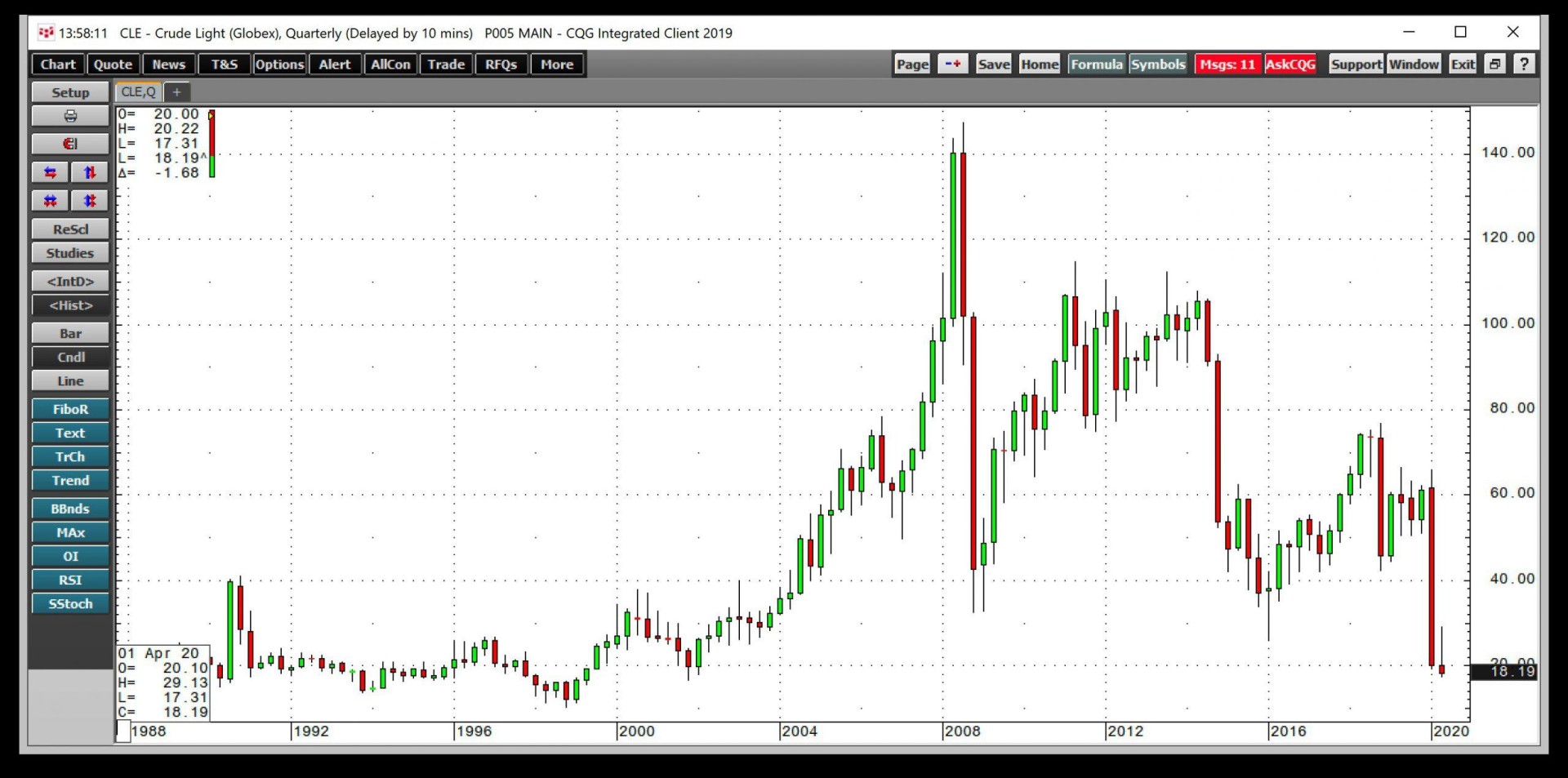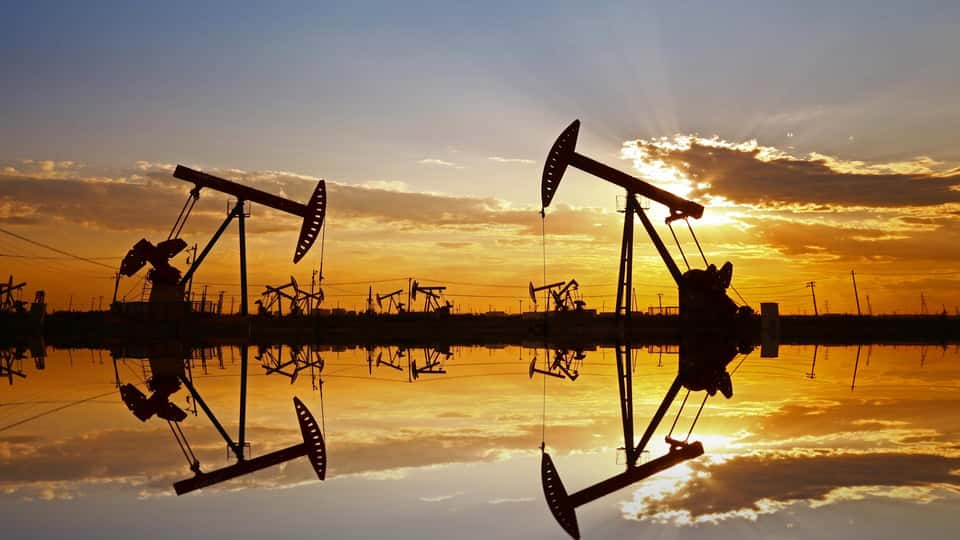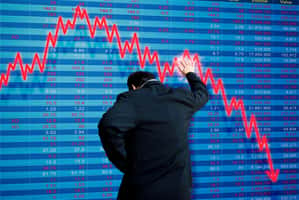- Risk-off and debt is an ugly combination
- Apache Corp. (APA) has had a volatile ride
- Occidental Petroleum Corp (OXY) swimming in debt after an ill-timed takeover
- Nabors Industries (NBR) – Drilling in a glut market is not a formula for success
The oil and gas sector had been struggling even when the stock market was rising to new all-time highs in 2019 and early 2020. When crude oil and natural gas prices rose, the shares of most energy companies lagged the moves. As the demand for energy commodities tanked on the back of Coronavirus, oil and gas-related shares moved appreciably lower.
Low interest rates over the past years encouraged many companies to take on significant levels of debt. As the United States rose to become the world’s leading oil and gas producing nation on the back of tax and regulatory reforms under the Trump administration since early 2017, the cost of output fell. Technological advances in extracting oil and gas from the crust of the earth pushed production costs even lower. However, the move to the downside in the prices of the energy commodities has driven many companies in the sector to the brink of bankruptcy. The shares of Apache Corporation (APA) and Occidental Petroleum (OXY) have fallen to their lowest level in decades. Shares of Nabors Industries (NBR), a drilling and drilling-services company, have collapsed. The price action in these three companies is a reason to only look towards the leaders in the energy sector like Exxon Mobile (XOM), Royal Dutch Shell (RDS-B), and British Petroleum (BP). In this environment, only the strongest companies that governments will support can survive.
Risk-off and debt is an ugly combination
Massive injections of stimulus from central banks and governments have stabilized the US stock market after the price carnage in March. Optimism that the world could be closer to the end of the global pandemic than the beginning has shifted the market’s sentiment, to a degree. However, the energy sector has ignored the rest of the market and continued to plunge last week.
OPEC, Russia, and other oil-producing nations agreed to a 9.7 million barrel per day but in output, the most significant reduction in history. The move did nothing to prevent oil from plunging to a new low. A cut of twenty or thirty million barrels is likely necessary to stabilize the price action in the petroleum market. As May NYMEX futures rolled to June at the end of last week, oil fell to a new and lower low.

(Source: CQG)
As the quarterly chart shows, the May futures contract reached $17.31 per barrel, the lowest price since 2001 in the aftermath of 9/11. Natural gas traded to a low of $1.555 per MMBtu on April 16, before bouncing to the $1.75 level on Friday. Natural gas recently traded to its lowest price in twenty-five years.
Oil and gas companies face the lowest levels in decades at a time when debt levels threaten their future. While the production of energy commodities is a matter of national security for the United States, only the most influential companies are likely to survive. Energy companies in the second tier and below are in more than a little trouble.
Apache Corp. (APA) has had a volatile ride
Apache Corporation (APA) explores for, develops, and produces natural gas, crude oil, and natural gas liquids. Before Coronavirus wreaked havoc on the oil market, APA shares experience a significant rally in January.

(Source: Barchart)
As the chart highlights, APA closed 2019 at $25.59 per share and rallied to a high of $33.77 on January 14 after APA and Total SA announced a substantial oil discovery off the coast of Suriname in South America. Last Friday, the shares of APA were at $8.23, less than one quarter the price just three months earlier. APA traded to a low of $3.80 per share on March 18. At just over $8 per share, APA was trading at its lowest level since the early 1990s; the March low was a level not seen since 1988. APA has had a volatile ride. It is hard to imagine that the company can survive a prolonged period of the lowest oil and gas prices decades. Servicing debt will be more than a challenge. Even if the company receives a bailout from the US government, equity holders could find themselves holding worthless shares. The promise of the offshore discovery could have been the final hurrah for APA.
Occidental Petroleum Corp (OXY) swimming in debt after an ill-timed takeover
Occidental Petroleum (OXY) has been in business since 1920. The centennial celebration of the company could market its end. In August 2019, OXY completed a $38 billion acquisition of Anadarko Petroleum. OXY’s market cap stood at $12.079 billion last week, less than one-third the price tag for Anadarko. The purchase gave a new meaning to dilutive M&A activity. At current oil and gas prices, servicing debt will be more than a challenge for OXY.

(Source: Barchart)
The chart shows that at $13.15 per share, OXY was trading at the lowest level 2002 at the end of last week. The March low of $9 was a level not seen since 2000. OXY is another company that could fade into the annals of history over the coming weeks and months.
Nabors Industries- Drilling in a glut market is not a formula for success
Nabors Industries (NBR) provides drilling and drilling-related services for land-based and offshore oil and gas wells in the US and Canada. In 2008, when oil and gas prices were at highs, NBR shares reached a peak of $50.58.

(Source: Barchart)
The chart highlights at the end of last week, NBR was trading at $0.2815 per share. The stock has become little more than a trading sardine and a lotto ticket.
Apache, Occidental, and Nabors all have valuable assets. However, all three companies are likely to become victims of the global pandemic as the unprecedented decline in demand for energy commodities will make it impossible for them to service debt and survive. The world’s leading energy companies from Saudi Arabia and Russia, as well as Exxon Mobile (XOM), British Petroleum (BP), and Royal Dutch Shell (RDS-B). are likely to be there to pick up the pieces over the coming months.
When it comes to investing, the odds of success with anything but the top oil companies that can lean on governments for aid amounts to purchasing lotto tickets. The odds are stacked heavily against investors in APA, OXY, and NBR shares.
Want More Great Investing Ideas?
9 “BUY THE DIP” Growth Stocks for 2020
7 “Safe-Haven” Dividend Stocks for Turbulent Times
Investors Beware: It’s Still Really Bad Out There!
OXY shares were trading at $11.99 per share on Tuesday morning, down $0.60 (-4.77%). Year-to-date, OXY has declined -70.02%, versus a -14.38% rise in the benchmark S&P 500 index during the same period.
About the Author: Andrew Hecht

Andy spent nearly 35 years on Wall Street and is a sought-after commodity and futures trader, an options expert and analyst. In addition to working with StockNews, he is a top ranked author on Seeking Alpha. Learn more about Andy’s background, along with links to his most recent articles. More...
More Resources for the Stocks in this Article
| Ticker | POWR Rating | Industry Rank | Rank in Industry |
| OXY | Get Rating | Get Rating | Get Rating |
| APA | Get Rating | Get Rating | Get Rating |
| NBR | Get Rating | Get Rating | Get Rating |






